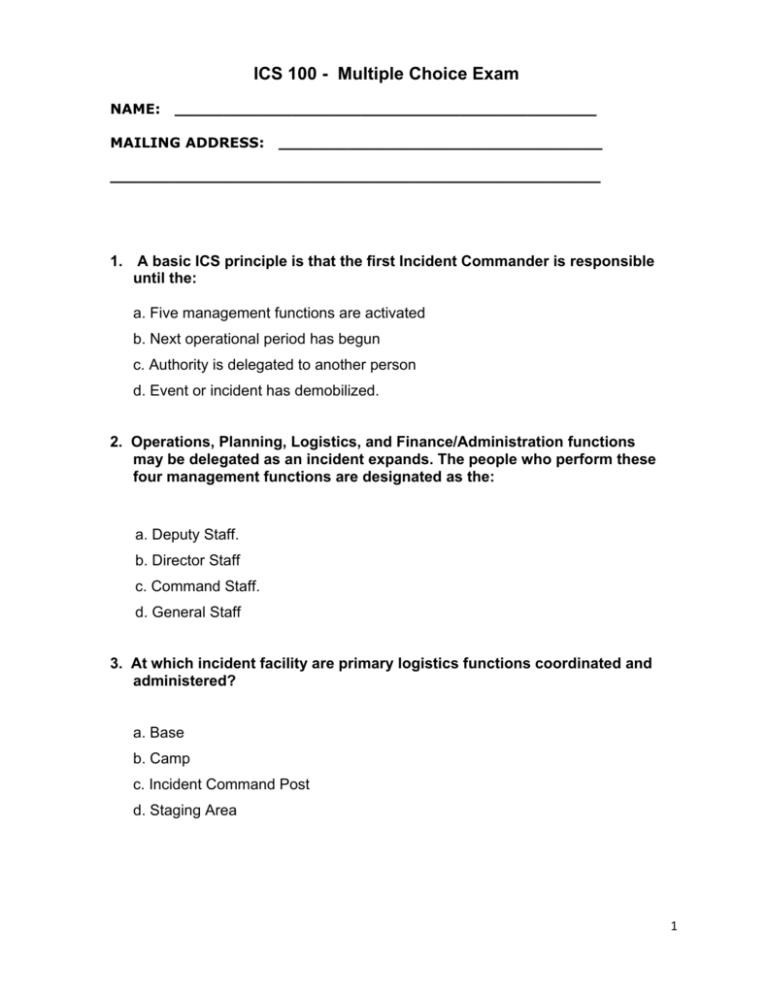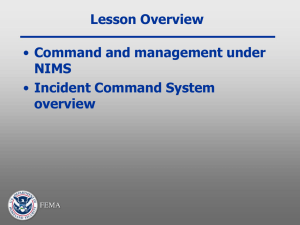ICS 100 Exam: Incident Command System Principles
advertisement

ICS 100 - Multiple Choice Exam NAME: ___________________________________________ MAILING ADDRESS: _________________________________ __________________________________________________ 1. A basic ICS principle is that the first Incident Commander is responsible until the: a. Five management functions are activated b. Next operational period has begun c. Authority is delegated to another person d. Event or incident has demobilized. 2. Operations, Planning, Logistics, and Finance/Administration functions may be delegated as an incident expands. The people who perform these four management functions are designated as the: a. Deputy Staff. b. Director Staff c. Command Staff. d. General Staff 3. At which incident facility are primary logistics functions coordinated and administered? a. Base b. Camp c. Incident Command Post d. Staging Area 1 4. Which position is the only one that is always staffed in ICS applications? a. Operations Section Chief b. Incident Commander c. Public Information Officer d. Safety Officer 5. ICS has been used to manage incidents such as fires, earthquakes, hurricanes, and acts of terrorism. Which of the following situations represents another viable application for the use of ICS? a. The planning and operation of Canada Day celebration, including the parade, fireworks display and entertainment. b. The oversight of safety issues associated with a freshman chemistry class throughout the fall and spring semesters. c. The management of nursing staff at the university hospital during weekend shifts. d. The oversight of the annual fiscal budget for a college library, including the procurement of new books. 6. The Incident Commander may need to designate personnel to provide public information, safety, and liaison services for the entire organization. In ICS, these personnel make up the: a. Deputy Staff b. Director Staff c. Command Staff d. General Staff 2 7. The purpose of the Incident Action Plan is to provide all incident supervisory personnel with direction for: a. Taking actions based on the objectives identified in the plan during the operational period. b. Maintaining documentation and tracking resources assigned to the incident. c. Monitoring the number of resources that report to any one supervisor d. Obtaining and maintaining essential personnel, equipment, and supplies. 8. The ability to communicate within ICS is absolutely critical. To ensure efficient, clear communication, ICS requires the use of: a. Agency-specific codes. b. Common terminology. c. Radio Codes. d. Technical language. 9. There is no correlation between the ICS organization and the administrative structure of any single agency or jurisdiction. This is deliberate because: a. Every incident or event requires that different management functions be performed. b. On small incidents and events, one person, the Incident Commander, may accomplish all five management functions. c. In ICS, the person at the top of the organization can act with less political pressure. d. Confusion over different position titles and organizational structures has been a significant stumbling block to effective incident management in the past. 3 10. Which General Staff position conducts tactical operations, develops the tactical objectives and organization, and directs all tactical resources? a. Finance/Administration Section Chief b. Logistics Section Chief c. Operations Section Chief d. Planning Section Chief 11. Which Command Staff position serves as the conduit between internal and external stakeholders, including the media, or other organizations seeking information directly from the incident or event? a. Public Information Officer b. Liaison Officer c. Resource Officer d. Safety Officer 12. At each level of the ICS organization, individuals in positions of primary responsibility have distinct titles. Using specific ICS position titles serves three important purposes: • The use of distinct titles allows for filling ICS positions with the most qualified individuals rather than by rank. • Standard position titles are useful when requesting qualified personnel. a. Titles provide a common standard for all responders. b. Distinct titles help clarify the activities undertaken by specific personnel. c. Position titles help to maintain the normal lines of authority within agencies. d. Prestige associated with certain titles helps to motivate responders. 4 13. Which General Staff position prepares and documents the Incident Action Plan, collects and evaluates information, maintains resource status, and maintains documentation for incident records? a. Finance/Administration Section Chief b. Logistics Section Chief c. Operations Section Chief d. Planning Section Chief 14. The ICS principle relating to the number of individuals or resources one incident supervisor can manage effectively is referred to as: a. Delegation of authority. b. Span of control. c. Form follows function. d. Unity of Command 15. Which General Staff position is responsible for ensuring that assigned incident personnel are fed and have communications, medical support, and transportation as needed to meet the operational objectives? a. Finance/Administration Section Chief b. Logistics Section Chief c. Operations Section Chief d. Planning Section Chief 16. Which Command Staff position monitors safety conditions and develops measures for assuring the safety of all assigned personnel? a. Public Information Officer b. Liaison Officer c. Resource Officer 5 d. Safety Officer 17. Which of the following would you expect to see in an Incident Action Plan? a. Detailed cost estimates for implementing the proposed activities b. Measurable tactical operations to be achieved within the specified period. c. Listing of all staff members currently deployed to the incident. d. A schematic showing all communication equipment in use at the incident. 18. Which incident facility is the location where personnel and equipment are kept while waiting for tactical assignments? a. Base b. Camp c. Incident Command Post d. Staging Area 19. Which General Staff position manages costs related to the incident, and provides accounting, procurement, time recording, and cost analyses? a. Finance/Administration Section Chief b. Logistics Section Chief c. Operations Section Chief d. Planning Section Chief 20. Which incident facility is positioned outside of the present and potential hazard area, but close enough to the incident to maintain command? a. Base b. Camp 6 c. Incident Command Post d. Staging Area 21. Check-in officially logs you in at the incident. The check-in process and information help to: • Ensure personnel accountability. • Track resources. • Prepare personnel for assignments and reassignments. • Organize the demobilization process. a. Determine procedures for reimbursing your headquarters. b. Identify purchasing authority and procedures c. Determine how food and lodging will be provided. d. Locate personnel in case of an emergency. 22. Which Command Staff position serves as the primary contact for supporting agencies assigned to an incident? a. Public Information Officer b. Liaison Officer c. Resource Officer d. Safety Officer 23. After check-in, you should: a. Locate your incident supervisor and obtain your initial briefing. b. Determine your return mode of transportation. c. Arrange personal items needed for your estimated length of stay. d. Report to the command post. 7 24. At which incident facility are resources kept to support incident operations if a Base is not accessible to all resources? a. Incident Command Post b. Camp c. Helibase d. Staging Area 25. Designers of the system recognized early that ICS must: • Meet the needs of incidents of any kind or size. • Provide logistical and administrative support to ensure that operational staff can meet tactical objectives. • Be cost effective by avoiding duplication of efforts. a. Require that a minimum number of personnel be deployed to perform administrative and logistics functions. b. Use certified emergency responders to serve as incident commanders and section chiefs. c. Allow personnel from a variety of agencies to meld rapidly into a common management structure. d. Compensate for incident response failures likely to result from a lack of resources. 8







